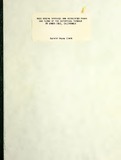Rock boring bivalves and associated fauna and flora of the intertidal terrace at Santa Cruz, California
| dc.contributor.advisor | Haderlie, E.C. | |
| dc.contributor.author | Clark, Gerald Wayne | |
| dc.date | September 1978 | |
| dc.date.accessioned | 2012-11-16T19:22:44Z | |
| dc.date.available | 2012-11-16T19:22:44Z | |
| dc.date.issued | 1978 | |
| dc.identifier.uri | https://hdl.handle.net/10945/18538 | |
| dc.description.abstract | Two areas along the intertidal terrace at Santa Cruz, California, were surveyed for rock boring bivalves. At one location, all associated macroscopic epibenthic fauna and flora were identified and quantified. Rock samples were collected representing all rock types where borers were found. Results showed that Penitella penita was the most abundant rock borer in both locations, being found to heights of 2+ meters above MLLW. The next most common borers were two species of Adula. Rock analysis showed that 32 out of 34 samples had calcium carbonate content less than 0.8% by weight, thereby indicating that in these locations the boring mechanism is probably not chemical | en_US |
| dc.description.uri | http://archive.org/details/rockboringbivalv1094518538 | |
| dc.language.iso | en_US | |
| dc.publisher | Monterey, California. Naval Postgraduate School | en_US |
| dc.rights | This publication is a work of the U.S. Government as defined in Title 17, United States Code, Section 101. Copyright protection is not available for this work in the United States. | en_US |
| dc.subject.lcsh | Oceanography | en_US |
| dc.title | Rock boring bivalves and associated fauna and flora of the intertidal terrace at Santa Cruz, California | en_US |
| dc.type | Thesis | en_US |
| dc.contributor.secondreader | Thompson, Warren C. | |
| dc.contributor.department | Oceanography | |
| dc.description.service | Lieutenant, United States Navy | en_US |
| etd.thesisdegree.name | M.S. in Oceanography | en_US |
| etd.thesisdegree.level | Masters | en_US |
| etd.thesisdegree.discipline | Oceanography | en_US |
| etd.thesisdegree.grantor | Naval Postgraduate School | en_US |
| dc.description.distributionstatement | Approved for public release; distribution is unlimited. |
Files in this item
This item appears in the following Collection(s)
-
1. Thesis and Dissertation Collection, all items
Publicly releasable NPS Theses, Dissertations, MBA Professional Reports, Joint Applied Projects, Systems Engineering Project Reports and other NPS degree-earning written works.


